Getting in on the AMD Ryzen Threadripper Pro transitioning from a Lenovo only part to a channel part, ASUS announced its solution. The ASUS Pro WS WRX80E-SAGE SE WIFI certainly does not lack for characters in its model name, but it does offer a tremendous platform for the chips we have dubbed the “WEPYC” or workstation EPYC platform. In this quick overview, we are going to look at what ASUS offers.
ASUS Pro WS WRX80E-SAGE SE WIFI Overview
The ASUS Pro WS WRX80E-SAGE SE WIFI is a massive motherboard. We do not have the exact specs since Asus has a non-functional tech specs page. Still, this looks like a SSI EEB size motherboard. That may make finding a chassis for the motherboard a bit more difficult than some of the other options we have looked at.
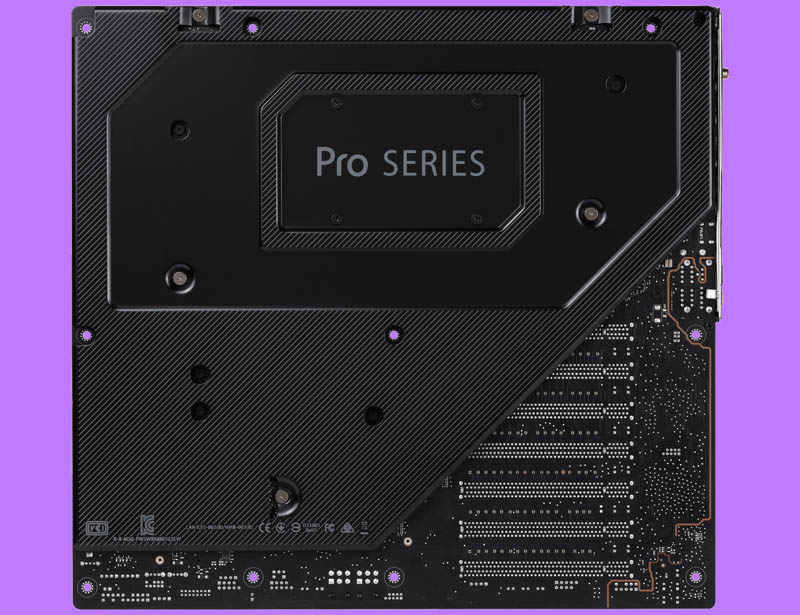
Unlike many of the other ASUS WS motherboards, this has the CPU socket and 8x DDR4-3200 RDIMM slots oriented to have server front to back airflow.
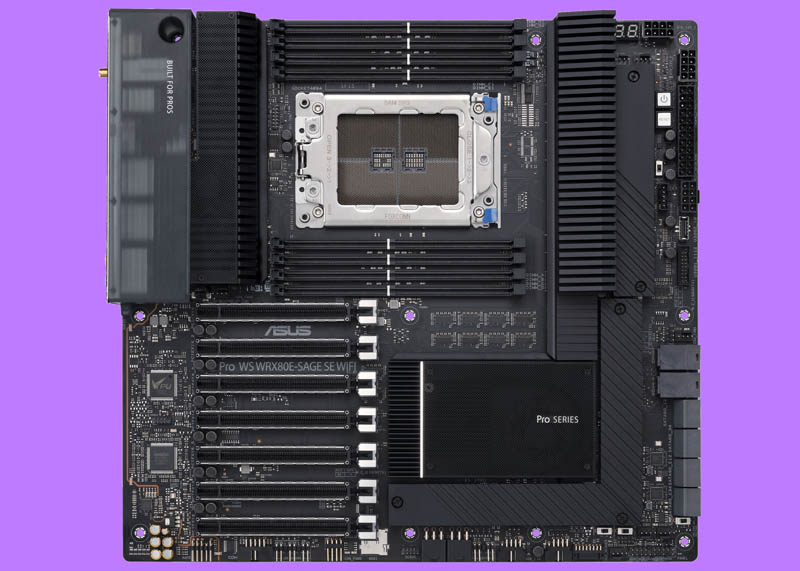
There are a total of seven PCIe Gen4 x16 slots onboard. That is 112 PCIe lanes worth plus lanes for the chipset and it seems like at least one of these will need to be an x8 to fit within the expanded Threadripper Pro PCIe limits.
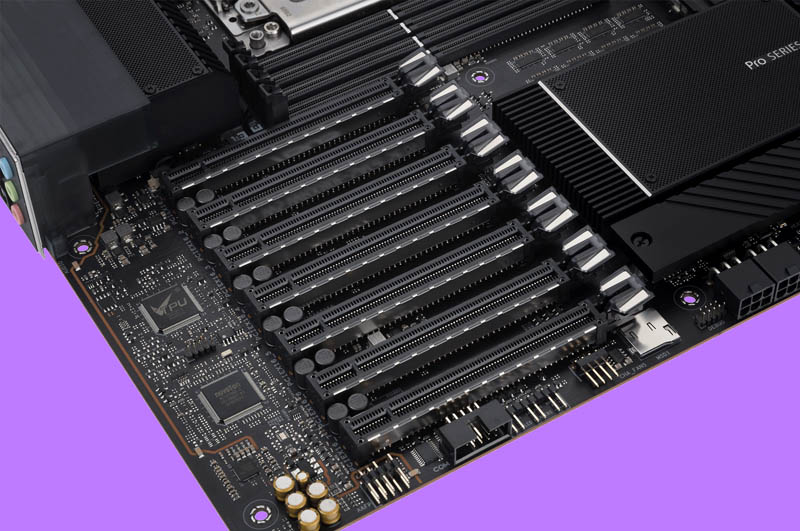
We can also see that there are three M.2 PCIe Gen4 lanes onboard. The ASUS listing also notes it has the “HYPER M.2 x16 Gen4 card” so this should mean optionally adding another four M.2 drives via an expansion card.
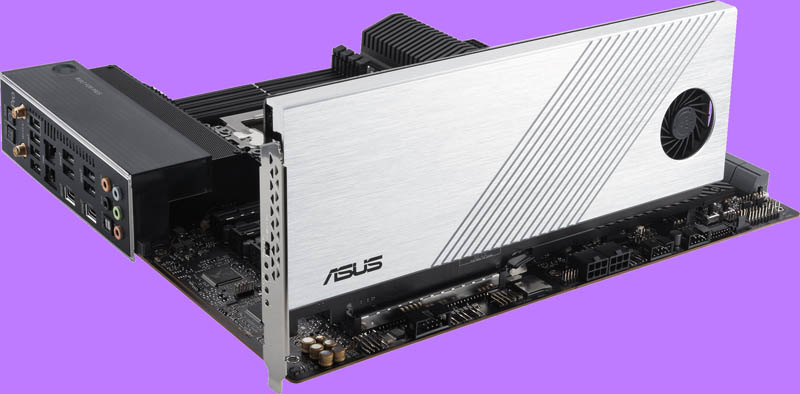
Other storage we see includes two U.2 and eight SATA ports at the edge of the motherboard. On the Gigabyte WRX80-SU8-IPMI, for example, we see that the U.2/ SlimSAS ports can be either PCIe for U.2 drives or 4x SATA III lanes. If ASUS enables this feature, we would get 16x SATA lanes possible as well.
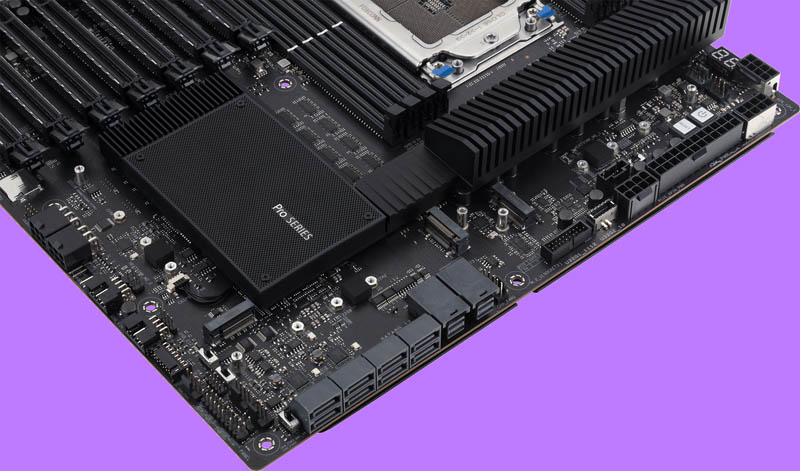
In terms of I/O, ASUS has USB 3.2 Gen 2×2 Type-C port, 10 x USB 3.2 Gen 2 ports. We also get audio as well as dual 10Gbase-T. The 10Gbase-T is powered by the Intel X550-AT2 similar to the Gigabyte solution. Supermicro and Lenovo are using the Marvell solution. Both the Supermicro and Gigabyte solutions have 1GbE NICs as well.

This is an enormous amount of 10Gbps USB ports and it is great to see even a USB Type-C 20Gbps port on the rear.
In order to round out the very large name, we have WiFi 6. One can see that we also have the Clear CMOS and BIOS update features found on ASUS’ consumer motherboards on here.
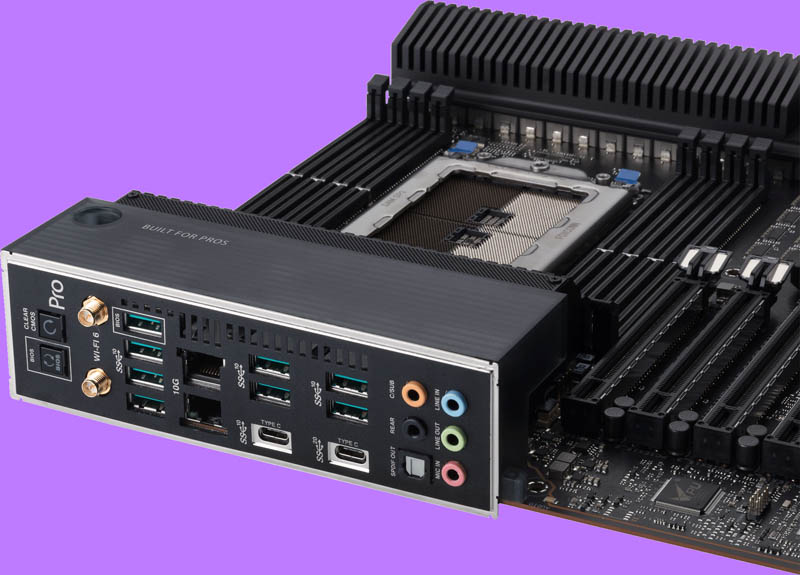
For management, ASUS has its ASMB9-iKVM solution. That is similar to what we see on the company’s servers such as the ASUS ESC4000A-E10 2U AMD EPYC GPU Server we reviewed. Something that is a bit different here is that the NIC is on a shared port since there is no dedicated port onboard. Also, since there are no 1GbE ports, the ASMB9-iKVM needs to be on a 10Gbase-T port.
Final Words
Overall, it is great to see that ASUS is making a statement. Given the sheer size of this motherboard, we hope that ASUS releases a chassis to go along with this platform. A chassis that could be either workstation or rackmount would be a great platform for the channel to use and offer high-end workstations using this motherboard. Both Lenovo with the P620 and Supermicro have systems approaches to the “WEPYC” market. If you want to learn more about the AMD Ryzen Threadripper Pro, you can see our AMD Ryzen Threadripper PRO 3995WX Review A Bold WEPYC and the video here.

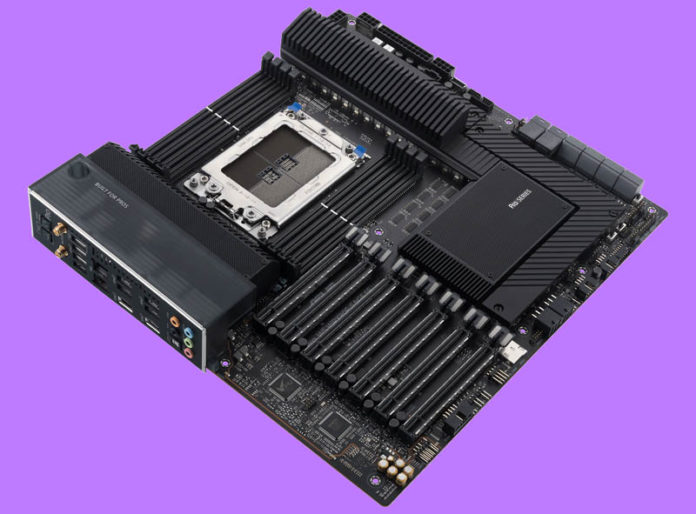
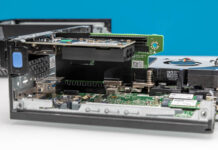


Thanks Cliff, that looks like a fantastic board. You know what though? My wallet just filed suit against me. It wants to get a restraining order.
“WEPYC”
Please stop with the cute names.
I’m inclined to agree with @Angelo. It was a funny one-off nickname. It does not age well.
Couldn’t we have had the same kind of product for regular Threadripper? Why did we only get stupid gaming crap with RGB and no BMC?
These WRX80 motherboards and Threadripper Pro look very attractive but I believe that most of the prosumers and enthusiasts will feel like having an icy shower once the prices are published. On the other hands, creative workshops will love it.
“… do not have the exact specs since Asus has a non-functional tech specs page. Still, this looks like a SSI EEB size motherboard.”.
The “Specifications” Tab is broken (empty) but the main page says that it’s an E-ATX: https://www.asus.com/Commercial-Motherboard/Pro-WS-WRX80E-SAGE-SE-WIFI/overview/
By comparison one of their Intel 7 slot workstation motherboards is CEB size, an inch bigger. The “Gallery” Tab also provides some closeups, showing the audio, etc.
I need this in my life somehow….
Yeah, these are the no-compromise professional workstation motherboards we’ve been waiting for, but I don’t think they’re going to be cheap.
Like other people said, it’s fair to assume it’s going to be expensive. Especially knowing that their only other AMD Pro board is in the pricier range of X570 boards.
Rob – we discussed this. If you look at those gallery images or images here you can see the mounting patterns have four holes across not three as we would normally see on EATX boards. We can see along the bottom/ top the typical EATX mounting points, and then the fourth points on PCB that continues to the edge. This is significantly larger than EATX.
Both EEB and E-ATX are maximum 13″ deep and 12″ high in a tower enclosure. What makes this an EEB board is the hole, third from the left at the bottom, marked K in EEB spec.
ATX spec: https://web.aub.edu.lb/pub/docs/atx_201.pdf
EEB spec: https://www.snia.org/sites/default/files/SSIF/2018-05-31/SSI%20EEB%202011%201.0.1.pdf